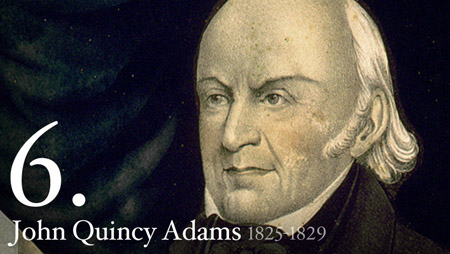
John Quincy Adams, the sixth President of the United States, served from March 4, 1825, to March 4, 1829. His presidency was marked by ambitious domestic policies and significant political challenges. This detailed timeline explores the key events and decisions that defined Adams’s presidency.
Inauguration and Early Administration (1825)
March 4, 1825: Inauguration
- John Quincy Adams is inaugurated as the sixth President of the United States. The election of 1824 was highly contentious and decided by the House of Representatives. Adams’s inaugural address emphasizes national unity, public improvements, and education.
July 4, 1825: Laying of the Cornerstone of the Chesapeake and Ohio Canal
- Adams participates in the ceremonial laying of the cornerstone for the Chesapeake and Ohio Canal, symbolizing his commitment to infrastructure projects and internal improvements.
Domestic Policies and Challenges (1825-1826)
1825-1829: American System
- Adams strongly supports the American System, proposed by Henry Clay, which includes federal investment in infrastructure, a national university, and scientific research. Despite Adams’s enthusiasm, many of his proposals face strong opposition in Congress, particularly from supporters of Andrew Jackson.
October 1825: Erie Canal Completed
- Although the project began during previous administrations, the completion of the Erie Canal during Adams’s presidency is a significant milestone in the development of the nation’s transportation infrastructure. The canal connects the Great Lakes with the Atlantic Ocean, facilitating trade and westward expansion.
1826: Tariff Debate
- Adams’s administration faces heated debates over tariffs. While Adams supports protective tariffs to foster American industry, opponents argue that such measures favor the industrial North at the expense of the agricultural South.
July 4, 1826: Deaths of John Adams and Thomas Jefferson
- On the 50th anniversary of the Declaration of Independence, both John Adams (John Quincy Adams’s father) and Thomas Jefferson pass away. Their deaths are significant national events, marking the end of an era of Founding Fathers.
Foreign Policy Initiatives (1827-1828)
1827: Pan-American Conference
- Adams advocates for a Pan-American Conference to promote cooperation among the nations of the Americas. The conference, held in Panama, faces domestic opposition and limited success, but it represents an early effort to foster inter-American relations.
1827: Trade Agreements
- Adams negotiates several trade agreements with European nations to expand American commerce. These agreements are part of his broader efforts to strengthen the U.S. economy through international trade.
The Election of 1828 and Political Struggles
1828: Tariff of Abominations
- The Tariff of 1828, known as the Tariff of Abominations, is passed by Congress. It imposes high duties on imported goods, benefiting Northern manufacturers but harming Southern planters. The tariff exacerbates sectional tensions and fuels opposition to Adams’s administration.
1828: Campaign of 1828
- The presidential election of 1828 is one of the most bitter and personal in American history. Andrew Jackson and his supporters accuse Adams of corruption and elitism, while Adams’s camp attacks Jackson’s character and background. The campaign marks the rise of modern political campaigning and party organization.
November 1828: Election Defeat
- Adams is defeated by Andrew Jackson in the presidential election. Jackson wins by a substantial margin, signaling a shift in American politics toward greater populism and the rise of the Democratic Party.
Conclusion of Adams’s Presidency (1829)
March 4, 1829: Departure from Office
- John Quincy Adams leaves office after one term, returning to Massachusetts. Despite his presidency being viewed as largely unsuccessful in achieving his ambitious goals, Adams remains active in public life and continues to contribute to national debates.
Post-Presidency and Legacy
1830: Election to the House of Representatives
- Adams is elected to the House of Representatives, where he serves for 17 years until his death. As a congressman, he becomes a leading advocate against slavery and a proponent of civil liberties.
1836: Gag Rule Controversy
- Adams fiercely opposes the “gag rule,” which prevents the discussion of anti-slavery petitions in the House. His persistent efforts to repeal the rule highlight his commitment to free speech and abolitionism.
1841: Amistad Case
- Adams successfully argues before the Supreme Court on behalf of African captives who had seized control of the Spanish ship Amistad. The court rules in favor of the captives’ freedom, a landmark case in the fight against slavery.
February 23, 1848: Death
- John Quincy Adams dies in Washington, D.C., after collapsing on the floor of the House of Representatives. His death marks the end of a long and distinguished career in public service.
Legacy and Impact
John Quincy Adams’s presidency is often viewed as a period of unrealized potential. His visionary proposals for national development, scientific advancement, and education faced strong opposition and limited implementation. Despite these challenges, Adams’s commitment to the principles of the American System laid the groundwork for future economic and infrastructural development.
Adams’s post-presidential career significantly shapes his legacy. As a congressman, his advocacy for abolition and civil liberties positions him as a moral leader in the fight against slavery. His role in the Amistad case and opposition to the gag rule demonstrate his unwavering dedication to justice and human rights.
Adams’s presidency also marks a transitional period in American politics, moving from the era of the Founding Fathers to a more populist and democratic political landscape. His defeat in the election of 1828 signals the rise of Andrew Jackson and the Democratic Party, reflecting changing political dynamics and the growing influence of the common man in American politics.
In conclusion, while John Quincy Adams’s presidency faced significant obstacles and is often viewed as less successful in terms of policy achievements, his broader contributions to American political life, both during and after his presidency, solidify his place as a key figure in the nation’s history. His dedication to national development, civil liberties, and anti-slavery efforts left a lasting impact on the United States.